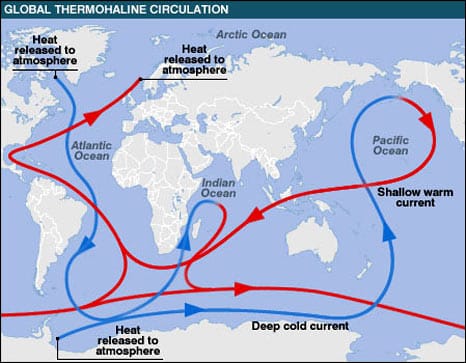- The process of the ocean water on Earth circulating due to heat and salinity.

- Thermo stands for heat, haline stands for salt.
- The less dense warm water flows over the more dense cool water
- This current is vulnerable to rising temperatures
- The salinity of the ocean water is decreasing near the poles due to the melting glaciers
- As the water contains less salt, it becomes less dense
- This is a problem because the density of the cool water is going to slowly becoming closer to the density of the warm water
- In time, the density of the ocean water mixed with the freshwater runoff may affect the global ocean currents
- As global temperatures increase, more ice will melt which in turn raises the temperature creating a feedback loop
- Some scientists conclude that at present rates, it will take around 100 years before the freshwater seriously affects the circulation
- Estimated 200 years worth of freshwater runoff before the conveyor belt completely stops
- Not a forecast, just the amount of freshwater needed to alter the global ocean currents
- The Atlantic “conveyor belt” would be the most affected because of the melting of the Arctic right above it and Greenland
- If the circulation were to slow down or malfunction, Europe would be cooler because the warm current heating it may no longer exist, although the warming temps may cause it to stay the same or warmer
- The marine life would be greatly affected because some depend on the ocean’s currents to navigate
- Oxygen is absorbed by the water and the cool temperatures cool down the water which sinks to the bottom of the ocean providing oxygen
- The circulation is slowing because the melted glaciers are making the top layer not dense enough to sink and the deep ocean is losing oxygen
- Deep ocean life would be affected because there isn’t enough oxygen in the water to survive
- This adds to the dead zones that are already increasing from to algae blooms
- Algae blooms are happening where fertilizers wash into the water where planktonic algae grow in mass amounts
- After theses planktonic algae die, they act as a fertilizer towards the microbes which use all the oxygen to decompose the matter

very helpful! 🙂